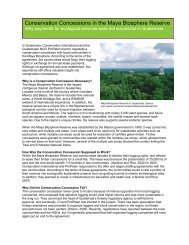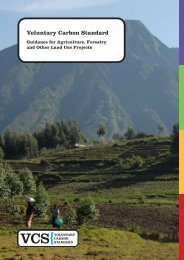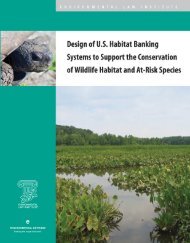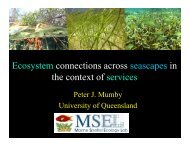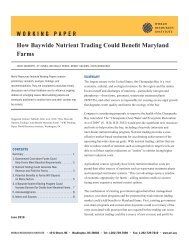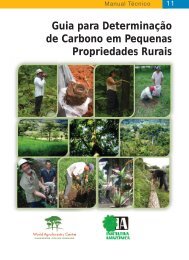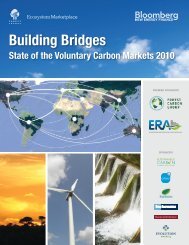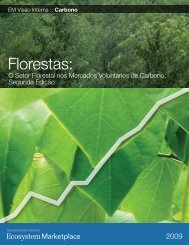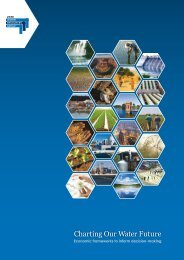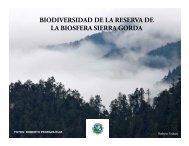Financial Accounting for Forestry Carbon Offsets - Ecosystem ...
Financial Accounting for Forestry Carbon Offsets - Ecosystem ...
Financial Accounting for Forestry Carbon Offsets - Ecosystem ...
Create successful ePaper yourself
Turn your PDF publications into a flip-book with our unique Google optimized e-Paper software.
!"#$#%"$&'(%%)*#+"#,'-).'<br />
!)./0+.1'2$.3)#'4--0/+0'<br />
By<br />
'<br />
Talitha Haller and Gabriel Thoumi<br />
Abstract<br />
Climate change, or as Dr. John Holdren, Co-Chair of the President’s Council of Advisors on Science and<br />
Technology, prefers “global climate disruption,” is occurring today on our Earth – our home. While the<br />
exact nature of the causes of these dramatic changes can be discussed, what we have observed over<br />
the past 150 year is an increase in our Earth’s mean temperature causing global climatic disruption.<br />
To mitigate global climate disruption, the <strong>for</strong>estry carbon market allows landowners to sequester<br />
atmospheric carbon dioxide in return <strong>for</strong> a payment <strong>for</strong> ecosystem service. This market has developed in<br />
three stages since 1988. In the first stage, which lasted until 2005, the <strong>for</strong>estry carbon market was an<br />
exotic boutique market with few if any regulations. In the second stage, which lasted until 2008, the<br />
<strong>for</strong>estry carbon market was a highly speculative niche market. In the current stage, the regulatory and<br />
institutional frameworks of the <strong>for</strong>estry carbon market are developing. From these frameworks, the<br />
<strong>for</strong>estry carbon market can easily expand into the global compliance market and become an everyday<br />
part of the lives of landowners and communities. In the meantime, one of the most important regulatory<br />
issues to be addressed <strong>for</strong> a viable quality market is <strong>for</strong>estry carbon financial accounting under<br />
International <strong>Accounting</strong> Standards (IAS) and U.S. generally accepted accounting principles (GAAP).<br />
The first section of this paper is an introduction to <strong>for</strong>estry carbon offsets as an alternative<br />
investment asset class with key lessons learned. The second section of this paper explains and<br />
analyzes different methods of accounting <strong>for</strong> <strong>for</strong>estry carbon offsets under IAS and U.S. GAAP.
5$.+'67'!)./0+.1'2$.3)#'(&+/.#$+"8/'9#8/0+:/#+'(00/+'2&$00'<br />
'<br />
Across the globe, hundreds of <strong>for</strong>estry carbon offset projects are under development.<br />
These projects primarily focus on our Earth’s “emeralds on the equator,” our tropical<br />
<strong>for</strong>est legacy that graces the Earth like a necklace. These “emeralds on the equator” are<br />
de<strong>for</strong>ested at a rate of 13 million hectares of <strong>for</strong>ests annually. As a result, de<strong>for</strong>estation<br />
accounts <strong>for</strong> roughly 20% of annual global anthropogenic greenhouse gas emissions<br />
originating from these de<strong>for</strong>estation practices (Gullison et al, 2007). Because trees and<br />
plants inhale carbon dioxide, it is possible to mitigate global climate disruption through<br />
developing <strong>for</strong>estry carbon offset projects, where landowners are paid to decrease<br />
emissions of carbon dioxide on their property by decreasing land conversion and<br />
unsustainable timbering activities. The <strong>for</strong>estry carbon offset market is a mechanism<br />
where stakeholders such as businesses or communities can choose to decrease their<br />
carbon emissions. If the decrease occurs through carbon financing and the ef<strong>for</strong>t is<br />
technically feasible, a <strong>for</strong>estry carbon offset may be generated. In these situations,<br />
businesses are paid to decrease their carbon emissions, providing economic incentives<br />
<strong>for</strong> achieving reductions in the emissions of pollutants. This is called cap and trade. It is<br />
where we can develop a “financial asset from an environmental liability” (Thoumi, 2009).<br />
<strong>Forestry</strong> carbon offset projects may be framed using the following models:<br />
! Development requires effective communication.<br />
! Development needs an appropriate business strategy.<br />
! Generation follows distinct stages.<br />
! Development must focus on intergenerational equity.<br />
! <strong>Forestry</strong> carbon offsets are an alternative investment asset class.<br />
! <strong>Forestry</strong> carbon offsets develop from real property rights.<br />
! Finance and sustainability frameworks conflict.<br />
Lesson #1: Effective Communication<br />
Successful <strong>for</strong>estry carbon offset projects have four components. These components<br />
<strong>for</strong>m the “Rational Convergence” business strategy model (see: Figure 1).<br />
Scientists will tell us that the "land dictates the rules" of the project. This means<br />
that we must understand environmental science qualities of the land that encompasses<br />
our project, and its surrounding locale. This implies that <strong>for</strong>estry carbon offset projects<br />
need to be flexible enough to be iterative and adaptively managed <strong>for</strong> un<strong>for</strong>eseen<br />
events, consequences, and outcomes (Thoumi, 2009).<br />
Local communities and their proxies in civil society such as international nongovernmental<br />
organizations will tell us "local communities are the gatekeepers of a<br />
project." This means we need to work within the local community to gain support <strong>for</strong> our<br />
<strong>for</strong>estry carbon project because local communities are the catalysts <strong>for</strong> project success.<br />
Governments “organize rights” and they will tell us that we need to work within<br />
their existing legal frameworks to develop a <strong>for</strong>estry carbon offset project. Yet these<br />
frameworks change over time and there may exist different legal criteria at different<br />
levels of government, whether local, provincial, national and international. Internationally
accepted "best-practices" may be preferred since this may mitigate project legal risk in<br />
the absence of sufficient local, provincial, and national laws.<br />
Businesses such as project developers “structure risks” yet <strong>for</strong>estry carbon offset<br />
projects succeed when they focus on mitigating risks, as opposed to maximizing profits.<br />
This is because the <strong>for</strong>estry carbon offset market is dominated by quality over quantity<br />
because higher quality credits receive a price premium.<br />
Finally, it is important to understand the four stakeholders’ situational and<br />
psychological profiles and their attitudes and concerns regarding the project’s returns,<br />
risks, legal and regulatory framework, tax, time horizons, liquidity concerns, and unique<br />
project co-benefits such as biodiversity and community development.<br />
Figure 1: Rational Convergence<br />
Lesson #2: <strong>Forestry</strong> <strong>Carbon</strong> Needs Appropriate Business Strategy<br />
The successful strategic approach to <strong>for</strong>estry carbon offset project development<br />
includes three stages. These stages are planning, screening, and implementation.<br />
! Planning: Each <strong>for</strong>estry carbon project is managed <strong>for</strong> aspects related to being real<br />
and measurable, permanent, transparent and credible, legal, marketable, and liquid,<br />
demonstrating co-benefits, having clear and prior consent of owners, minimizing<br />
business risk, minimizing sovereign risk, and providing assurance of completion.<br />
! Screening: Each <strong>for</strong>estry carbon project is screened <strong>for</strong> aspects related to<br />
legitimacy, legality, and <strong>for</strong>estry carbon offset estimation (see Figure 2: Screening<br />
Tool). Various legal interpretations of laws at the four levels of jurisprudence – local,<br />
provincial, national, and international – can create confusion <strong>for</strong> the project owner.<br />
Page 3 of 27!
This is why it is important to focus project strategy on the intersection between<br />
legality, legitimacy, and <strong>for</strong>estry carbon offset estimation.<br />
'<br />
Figure 2: Screening Tool<br />
!<br />
! Implementation: Each <strong>for</strong>estry carbon project is developed with a complex systems<br />
approach to implementation, validation and verification, monitoring, adjustment, and<br />
sales. This approach is necessary <strong>for</strong> projects to realize successful outcomes.<br />
Lesson #3: Generation Stages of <strong>Forestry</strong> <strong>Carbon</strong> Credits<br />
Figure 3: <strong>Forestry</strong> <strong>Carbon</strong> Offset Direct Sales Process<br />
Market participants generally use a direct sales model where <strong>for</strong>estry carbon offsets are<br />
sold directly to an emitter (see Figure 3: <strong>Forestry</strong> <strong>Carbon</strong> Offset Direct Sales Process).<br />
Generation has three stages: raw materials sourcing, validation/verification, and sales.<br />
Page 4 of 27!
! Raw Materials Sourcing: A project owner needs to have clean and clear title to the<br />
land. This title must be registered with the appropriate authorities. The project owner<br />
also needs to have clear and prior consent to own and sell <strong>for</strong>estry carbon offsets<br />
generated from trees on their property.<br />
! Validation and Verification: Project developers assemble all the parts needed <strong>for</strong><br />
<strong>for</strong>estry carbon offsets. The <strong>for</strong>estry carbon project developer delivers the technical<br />
documents to a third-party certification mechanism <strong>for</strong> third-party independent<br />
verification. After successful verification, the new <strong>for</strong>estry carbon offsets are issued<br />
and placed into a third-party independent registry where transactions can occur.<br />
! Sales: Buyers have five reasons to purchase credits. They purchase credits <strong>for</strong><br />
compliance to regulated markets, pre-compliance to regulated markets, investing <strong>for</strong><br />
a financial return, carbon neutral products’ offsetting, and public relations reasons.<br />
Recent purchases include:<br />
A. 600,000 tons purchased by Pacific, Gas and Electric <strong>for</strong> US$ 9.71 per ton, a<br />
sale of $5,826,000. Tons are sold ex-post under the Climate Action Reserve<br />
mechanism (Lake County News, 2009).<br />
B. 500,000 tons purchased by HEAG <strong>for</strong> US$ 8 per ton; $4,000,000 total sale.<br />
Tons are sold ex-post under ISO 14064:2 (ERA <strong>Carbon</strong> <strong>Offsets</strong> Ltd., 2009).<br />
C. 522,000 tons purchased by the Norwegian government <strong>for</strong> roughly US$ 14.00<br />
per ton and total sale of $7,308,000. Tons are sold ex-post under the New<br />
Zealand Permanent Forest Sink Initiative (<strong>Carbon</strong> Finance, 2009).<br />
D. 500,000 tons purchased by The World Bank <strong>for</strong> an unknown price, sold exante<br />
from the Ibi Bateke <strong>Carbon</strong> Sink Plantation Project (World Bank, 2009).<br />
Buyers need transparency to price comparison shop. Sellers need liquidity to sell offsets<br />
efficiently and effectively. Regulators need a market providing assurance of completion.<br />
Lesson #4: <strong>Forestry</strong> <strong>Carbon</strong> Must Focus on Intergenerational Equity<br />
One can split businesses into two groups – those that create value and those that<br />
appropriate or take value (Afuah, 2009). Because <strong>for</strong>estry carbon projects should<br />
directly improve carbon sequestration and indirectly improve other ecosystem services,<br />
it is possible to discuss <strong>for</strong>estry carbon assets as value creation projects: the sum of the<br />
whole at the end of the process is greater than the sum of the whole at the beginning.<br />
<strong>Forestry</strong> carbon projects usually span 20 to 100 years. Consequently, one can discuss<br />
<strong>for</strong>estry carbon projects in the context of intergenerational equity.<br />
Lesson #5: <strong>Forestry</strong> <strong>Carbon</strong> is an Alternative Investment Asset Class<br />
With <strong>for</strong>estry carbon, one can develop a “financial asset from an environmental liability”.<br />
The source of this financial asset is the natural capital of the land and the activities<br />
engaging this natural capital, which make up the geographic and ecological landscape<br />
of the properties held by these landowners. This natural capital, or natural hegemony,<br />
Page 5 of 27!
develops <strong>for</strong>estry carbon projects as a new alternative asset class with its specific risk<br />
and return profiles depending on the quality of the project.<br />
'<br />
Lesson #6: <strong>Forestry</strong> <strong>Carbon</strong> Develops from Real Property Rights<br />
Forestland is real property, and a <strong>for</strong>estry carbon project needs to be understood within<br />
this context. Its legal rights that transfer to the buyer are related to real property<br />
ownership, with rights of possession including boundaries establishment, the rights to<br />
control how the land is used, the rights to benefits arising from the land, and the rights<br />
to give, sell, encumber or bequeath rights or a portion of rights to others (McEvoy,<br />
1998). A <strong>for</strong>estry carbon project must develop the legal capacity to “give, sell, encumber<br />
or bequeath rights or a portion of rights to others” in a commercially viable manner while<br />
protecting the public interest of the location where the rights originate.<br />
Lesson #7: Finance and Sustainability Conflict<br />
<strong>Financial</strong> institutions play a key role in sustainable economic development. If we define<br />
sustainability as a rational land ethic that incorporates equitable utilization, the no-harm<br />
principle, cooperation and sustainability, then <strong>for</strong>estry carbon projects may yield results<br />
that are inherently conditioned to develop intergenerational equity. Equitable utilization<br />
is the efficient and fair distribution of natural resources. The no-harm principle means<br />
that harm to an ecological system is not done today in an ef<strong>for</strong>t to extract economic rent<br />
in lieu of consideration <strong>for</strong> tomorrow. Cooperation means that firms, individuals, nations,<br />
and municipalities need to work within an adaptive management framework that is<br />
iterative with affirmative prescriptive laws to manage their shared natural resources.<br />
Sustainability in this context is not a circular reference, but rather it refers to developing<br />
a biophysical systems perspective. The precautionary principle means that actions must<br />
demonstrate they will not cause harm today or in the future. The burden of proof lies<br />
with the proponents of the action and the action itself.<br />
How finance currently operates in society is not congruent with the principles of<br />
this sustainability framework. Current financial analysis has the following three flaws:<br />
discounting without a rational time horizon, accounting <strong>for</strong> natural resources that does<br />
not reflect ecological resources, and the separation of growth and development as<br />
applied to infinite and finite resources.<br />
! Discounting: Discounting finds the present value of cash flows today by using the<br />
time value of money equation. The capital asset pricing model (CAPM) can be used<br />
to calculate a discount rate. In CAPM, the discount rate is calculated as the sum of<br />
the risk-free rate and beta multiplied by the equity risk premium. There are flaws<br />
within CAPM. For instance, beta, which can be calculated using various methods, is<br />
intrinsically only an educated guess regarding the volatility of a firm or underlying<br />
asset versus its appropriate benchmark or index.<br />
! <strong>Accounting</strong>: How we report on natural resources also has discrepancies. For<br />
example, methods to account <strong>for</strong> non-sustainable extractive services, such as <strong>for</strong><br />
Page 6 of 27!
coal, do not apply a limit to the amount that can be extracted from a mine given the<br />
growth rate of the resource. This approach to extractive resources is not sustainable.<br />
! Growth Potential: Analysis of growth potential in finance does not make a coherent<br />
separation between growth and development and finite and infinite (see Figure 4:<br />
Development, Growth, and Natural Capital Accretion). Growth and development are<br />
not inherently the same process. One can have development without growth, and<br />
one can have growth without development. Development implies overall progress <strong>for</strong><br />
the community in a sustainable <strong>for</strong>-profit fashion. Because the Earth has limited<br />
resources, our economic systems should use resources more efficiently with the<br />
goal of creating intergenerational equity. In summary, any financial analysis could be<br />
compared to a baseline where “resources are used sustainably <strong>for</strong>-profit at a finite or<br />
natural rate of natural capital accretion.”<br />
!<br />
Development<br />
Growth<br />
Finite Resources used<br />
sustainably <strong>for</strong>-profit at<br />
finite or natural rate of<br />
natural capital accretion<br />
Resources used<br />
unsustainably <strong>for</strong>-profit at a<br />
finite or natural rate of<br />
natural capital accretion<br />
Infinite Resources used<br />
sustainably <strong>for</strong>-profit at an<br />
infinite rate of natural<br />
capital accretion<br />
Resources used<br />
unsustainably <strong>for</strong>-profit at<br />
an infinite rate of natural<br />
capital accretion<br />
Figure 4: Development, Growth, and Natural Capital Accretion<br />
!<br />
Page 7 of 27!
5$.+';7'!"#$#%"$&'(%%)*#+"#,'-).'!)./0+.1'2$.3)#'4--0/+0'<br />
'<br />
At present, the International <strong>Accounting</strong> Standards Board (IASB) and the U.S. <strong>Financial</strong><br />
<strong>Accounting</strong> Standards Board (FASB) offer no guidance on how entities should account<br />
<strong>for</strong> voluntary emissions reductions, including <strong>for</strong>estry carbon offsets. Consequently,<br />
there is a lack of consensus as to how emissions reductions should be accounted <strong>for</strong> on<br />
the balance sheet and the income statement.<br />
I. The Value of <strong>Accounting</strong><br />
In order <strong>for</strong> the <strong>for</strong>estry carbon market to adequately function and further develop, clear<br />
accounting standards <strong>for</strong> these assets must be established. Entities possessing <strong>for</strong>estry<br />
carbon offsets currently have no accounting guidance to follow. As a result, different<br />
entities are using different accounting methods, hindering in<strong>for</strong>mation transparency in<br />
the market. Lack of uni<strong>for</strong>m accounting makes it nearly impossible to fairly compare<br />
financial statements across entities such as project developers. Entities also struggle<br />
with the time and resources required to determine the most appropriate accounting<br />
treatment, and this difficulty is exacerbated when an organization follows both a GAAP<br />
and IAS. Until accounting guidance is issued, difficulty regarding in<strong>for</strong>mation<br />
transparency and comparability will persist.<br />
In May 2007, PricewaterhouseCoopers (PwC) and the International Emissions<br />
Trading Association (IETA) released a survey of 26 major European organizations<br />
affected by the EU Emissions Trading Scheme (ETS). The survey looked at the<br />
accounting approaches <strong>for</strong> ETS allowances and Certified Emission Reductions (CERs),<br />
both acquired and self-generated (IETA and PwC, 2007). Although the study relates to<br />
the EU compliance market, its findings may provide insight <strong>for</strong> the voluntary market.<br />
Specifically, findings on self-generated emissions reductions may reflect similar trends<br />
and issues as those encountered by entities in the voluntary <strong>for</strong>estry carbon market.<br />
The survey found that on the balance sheet, 29% of participants accounted <strong>for</strong><br />
self-generated CERs as inventory upon generation, at an allocated cost of production;<br />
13% recorded the CERs as intangible fixed assets, at fair value; 29% did not recognize<br />
the CERs until they were used/sold; and 29% used other treatments. The decision not<br />
to recognize CERs until they are used/sold may suggest that the organization<br />
anticipates no future economic benefits from the offsets (IETA and PwC, 2007). For the<br />
purpose of this paper, however, we assume classification of offsets as assets. This may<br />
be consistent with existing guidance.<br />
According to IASB, an asset “is a resource controlled by the entity as a result of<br />
past events and from which future economic benefits are expected to flow to the entity”<br />
(IASC Foundation, 2009). FASB similarly defines an asset as “probable future economic<br />
benefits obtained or controlled by a particular entity as a result of past transactions or<br />
events” (FASB, 2009). Whether the offset is sold pre-verification or ex-post, money<br />
exchanges hands in return <strong>for</strong> offset ownership rights. A buyer may bank and later sell<br />
<strong>for</strong>estry offsets or use them to settle compliance or pre-compliance emissions<br />
obligations. Accordingly, <strong>for</strong>estry offsets may qualify as assets <strong>for</strong> financial accounting<br />
purposes because they are entity controlled and provide future economic benefits.<br />
Page 8 of 27!
Despite the lack of clear rules, various accounting methods applicable to offsets<br />
are present in existing standards under IAS and U.S. GAAP. With the assumption that<br />
<strong>for</strong>estry offsets are classified as assets, we focus on the two remaining accounting<br />
treatments found in the survey: inventory and intangible assets. In determining the<br />
appropriate accounting <strong>for</strong> <strong>for</strong>estry carbon offsets, considering their character is<br />
imperative. The use of the offsets determines their nature, which in turn dictates how<br />
they should be classified in the financial statements (see Figures 7-10).<br />
The following sections explain inventory and intangible assets in financial<br />
accounting along with details of cost accounting <strong>for</strong> self generated offsets. <strong>Forestry</strong><br />
carbon offsets can be classified in the financial statements as either inventory or<br />
intangible assets. The offsets can be held at fair value, net realizable value, or cost. Fair<br />
value and net realizable value are based on market prices; however, without an active<br />
market <strong>for</strong> the offsets, it may be prudent to record them at cost. This value is either what<br />
an entity purchases its offsets <strong>for</strong> or the cost the entity incurs to manufacture the offsets.<br />
If an entity self generates offsets, it may use cost accounting to arrive at a unit cost<br />
regardless of classification as inventory or intangible assets. This unit cost is the<br />
amount recorded on the balance sheet and eventually expensed on the income<br />
statement when the offsets are sold.<br />
II. Inventory<br />
A project developer may choose to account <strong>for</strong> <strong>for</strong>estry carbon offsets as inventory on<br />
the balance sheet at cost. International <strong>Accounting</strong> Standard (IAS) 2, Inventories, does<br />
not apply to biological assets related to agriculture, and its measurement requirements<br />
do not apply to inventories held by producers of agricultural and <strong>for</strong>est products;<br />
however, lack of guidance remains <strong>for</strong> <strong>for</strong>estry carbon products (IASC Foundation,<br />
2009). IAS and U.S. GAAP define inventory similarly, as assets:<br />
A. Held <strong>for</strong> sale in the ordinary course of business;<br />
B. In the process of production <strong>for</strong> such sale in the ordinary course of business; or<br />
C. In the <strong>for</strong>m of materials or supplies to be consumed in the production process or in<br />
the rendering of services (IASC Foundation, 2009).<br />
!<br />
If an entity sells <strong>for</strong>estry carbon offsets as part of its normal operations, or uses them to<br />
settle emissions liabilities in its ordinary course of business, offsets could classify as<br />
inventory under IAS 2. As such, they should be measured at lower of cost and net<br />
realizable value. Inventory costs include all costs sustained to bring the inventory to its<br />
present state and location, including purchase and conversion costs. Net realizable<br />
value equals the estimated, ordinary selling price less estimated costs to complete the<br />
sale – in effect, the net amount an entity expects to realize. IAS 2 permits inventory<br />
costs to be assigned by first-in first-out (FIFO) or weighted average cost <strong>for</strong>mulas.<br />
U.S. GAAP requires inventory to be measured slightly differently; according to<br />
SFAS 151, Inventory Costs, inventory is measured at lower of cost or market (FASB,<br />
2008). Unlike under IAS, US GAAP also allows the FIFO method <strong>for</strong> assigning inventory<br />
Page 9 of 27!
costs. To measure cost from a project owner or buy side perspective, the credits would<br />
likely be recorded at purchase cost; from a developer perspective, the credits could also<br />
be valued at an allocated cost of production (see: Manufactured Product).<br />
Inventory Example<br />
In the following example, a landowner hires a project developer to generate <strong>for</strong>estry<br />
carbon offsets on their property, regardless of the <strong>for</strong>estry asset class. The project<br />
developer sells the credits to a wholesaler. Using our generation analogy, a carbon<br />
<strong>for</strong>estry project has three stages: raw materials sourcing, generation, and sales. The<br />
transaction looks like this (see Figure 5: <strong>Forestry</strong> VER Inventory Sale Diagram):<br />
Figure 5: <strong>Forestry</strong> VER Inventory Sale Diagram<br />
!<br />
Page 10 of 27!<br />
'
Example<br />
A broker purchases 1,000 credits from a developer whose project is based in the Central<br />
American rain<strong>for</strong>est. Purchase price is $5 per credit; unit cost <strong>for</strong> the developer is $2.<br />
The total amount the broker pays in the sale is $5,000. The broker records the $5,000 sale on its<br />
balance sheet as inventory. The journal entry <strong>for</strong> the broker’s purchase is as follows:<br />
Inventory 5,000<br />
Accounts payable 5,000<br />
The gross amount the developer realizes from the sale is also $5000 (less any selling costs, but<br />
<strong>for</strong> this example we will assume the developer incurs no costs to sell the credits). The developer<br />
also realizes costs of goods sold related to the credits of $2,000. The developer reduces<br />
inventory on its balance sheet and records the following journal entry <strong>for</strong> the sale:<br />
Accounts receivable 5,000<br />
Sales 5,000<br />
Cost of goods sold 2,000<br />
Inventory 2,000<br />
When the broker pays the developer <strong>for</strong> the credits, it makes the following entry:<br />
Accounts payable 5,000<br />
Cash 5,000<br />
The developer makes the following entry when it receives payment from the broker:<br />
Cash 5,000<br />
Accounts receivable 5,000<br />
The broker now maintains this inventory on its balance sheet at lower of cost or market under US<br />
GAAP or at lower of cost or net realizable value under IAS. If we follow the assumption there are<br />
no selling costs associated with the sale of credits, then the value of the inventory is the same<br />
regardless of whether US GAAP or IAS is followed. When the broker subsequently sells the<br />
credits to a buyer, it removes the cost of inventory sold from the inventory account on its balance<br />
sheet and transfers it to cost of goods sold, an expense account on the income statement. !<br />
!<br />
!<br />
!
Trading Inventory<br />
Broker inventories of tradable assets such as commodities are exempt from IAS 2<br />
measurement rules, given such inventories are measured following the industry<br />
convention at fair value less cost to sell. Periodic changes are thus recognized in profit<br />
or loss on the income statement. When tradable inventories are not measured at fair<br />
value less costs to sell, they are subject to measurement as per IAS 2, lower of cost and<br />
net realizable value. This is relevant in accounting <strong>for</strong> <strong>for</strong>estry carbon offsets because at<br />
present an active market <strong>for</strong> them – a transparent market with day-to-day liquidity and<br />
transactions that have assurance of completion with standardized contracts – does not<br />
yet exist. Without an active market, offsets cannot be held at fair value as trading<br />
inventory. There<strong>for</strong>e, offsets traded on the voluntary market may be valued on the<br />
balance sheet at lower of cost (likely the cost of purchase) and net realizable value. This<br />
measurement is also consistent with U.S. generally accepted accounting principles<br />
(FASB, 2008), which require measurement at lower of cost or market. Although FASB<br />
believes that fair value is the more appropriate measurement <strong>for</strong> inventories in trading<br />
activities (FASB, 2008), it does not require their measurement at fair value.<br />
In the trading inventory scenario, we assume a landowner hires a project<br />
developer to generate <strong>for</strong>estry carbon offsets on their property, regardless of the<br />
<strong>for</strong>estry asset class. The project developer sells the offsets to a wholesaler who then<br />
sells the credits to an emitter. Using our generation analogy again, a carbon <strong>for</strong>estry<br />
project has three stages: raw materials sourcing, generation, and sales. The transaction<br />
looks like this (see Figure 6: <strong>Forestry</strong> VER Trading Inventory Diagram).<br />
Figure 6: <strong>Forestry</strong> VER Trading Inventory Diagram<br />
!<br />
!
III. Intangible Assets<br />
Entities such as landowners, project developers, and buyers may find it appropriate to<br />
account <strong>for</strong> <strong>for</strong>estry carbon credits as intangible assets. This section first explains<br />
intangible assets under IAS and follows with an intangibles overview under U.S. GAAP.<br />
IAS Requirements<br />
IAS 38, Intangible Assets (IASC Foundation, 2009), applies to identifiable, nonmonetary<br />
assets without physical substance. Outside the scope of this standard are<br />
financial assets, recognition and measurement of exploration and evaluation assets,<br />
and development and extraction expenditures on minerals, oil, and natural gas.<br />
Additionally, IAS 38 does not apply to intangibles covered by another Standard. For<br />
example, intangibles sold in the ordinary course of business fall outside the Standard,<br />
<strong>for</strong> they are within the scope of IAS 2, Inventories. In addition to meeting the minimum<br />
scope requirements, an item must also meet the definition of an intangible asset:<br />
A. The asset is identifiable;<br />
B. The entity has effective control over the asset;<br />
C. There exist future economic benefits<br />
Off-Balance Sheet Intangibles<br />
Currently, the requirements <strong>for</strong> recognition of intangible assets are quite stringent. If an<br />
entity cannot sufficiently meet the definition and requirements (described below) <strong>for</strong> its<br />
intangible assets, including establishing a connection between costs incurred and<br />
probable future economic benefits, the assets may not be recognized in the financial<br />
statements. This is the likely outcome <strong>for</strong> voluntary credits because an active market <strong>for</strong><br />
them does not yet exist. When intangibles cannot be recognized on the financial<br />
statements, costs are expensed as incurred rather than capitalized as an asset on the<br />
balance sheet. In effect, the project is recognized on the financial statements as a<br />
series of expenditures. If the market <strong>for</strong> voluntary credits becomes active in the future,<br />
such assets could possibly qualify <strong>for</strong> recognition on the balance sheet. Even so, only<br />
certain development costs are capitalized. The following sections <strong>for</strong> internally<br />
generated and separately acquired intangibles, along with their subsequent<br />
measurement, relate to intangible assets recognized on the balance sheet.<br />
Internally Generated Intangibles<br />
An internally generated intangible asset is commonly generated in two phases, a<br />
research phase and a development phase. The research phase includes costs<br />
associated with gaining new knowledge, finding materials and designing, among others,<br />
and does not result in an intangible asset with the ability to produce future economic<br />
benefits. Research costs are expensed as incurred. The development phase, on the<br />
other hand, applies findings from the research phase to its plans or designs <strong>for</strong> the<br />
asset. Development may result in recognition of an intangible asset if the project<br />
developer can establish the following:<br />
Page 13 of 27!<br />
'
A. The technical feasibility of completing the intangible asset so that it will be available<br />
<strong>for</strong> use or sale;<br />
B. Its intention to complete the intangible asset and use or sell it;<br />
C. Its ability to use or sell the intangible asset;<br />
D. How the intangible asset will generate probable future economic benefits. Among<br />
other things, the entity can demonstrate the existence of a market <strong>for</strong> the output of<br />
the intangible asset or the intangible asset itself or, if it is to be used internally, the<br />
usefulness of the intangible asset;<br />
E. The availability of adequate technical, financial and other resources to complete the<br />
development and to use or sell the intangible asset; and<br />
F. Its ability to measure reliably the expenditure attributable to the intangible asset<br />
during its development.<br />
Costs included in the measurement of an internally generated intangible asset are those<br />
incurred from the date the intangible meets the recognition criteria above. They include:<br />
A. Costs of materials and services used or consumed in generating the asset;<br />
B. Costs of employee benefits arising from the generation of the asset;<br />
C. Fees to register a legal right; and<br />
D. Amortization of patents and licenses that are used to generate the asset.<br />
Specific costs <strong>for</strong> a project developer may include:<br />
A. Land title acquisition, lease, and / or title insurance;<br />
B. Technical data;<br />
C. Implementation;<br />
D. Validation, monitoring, and verification;<br />
E. Commercialization costs including registration, carbon insurance, and issuance.<br />
Separately Acquired Intangibles<br />
As with internally generated intangible assets, those acquired separately in a purchase<br />
must meet the requirements regarding expected future economic benefits and reliably<br />
measurable cost. The cost of the separately acquired intangible asset includes both the<br />
purchase price and direct costs necessary to put the asset to its intended use. The<br />
intangible is recorded on the balance sheet at this acquisition cost. Once an asset is in<br />
its necessary operating condition, subsequent redeployment or operating costs are no<br />
longer included in the carrying amount of the asset. Instead, these costs are<br />
immediately expensed.<br />
Subsequent Measurement<br />
After the initial recognition of an intangible asset, whether self-generated or acquired,<br />
the entity may choose to account <strong>for</strong> the intangible using the cost model or the<br />
revaluation model. In the cost model, an entity carries its intangibles at cost less<br />
amortization (if the asset has a finite useful life) and any impairment. Because voluntary<br />
Page 14 of 27!<br />
'
offsets have an indefinite useful life, they likely should not be amortized. In the<br />
revaluation model, an entity carries its intangibles at fair value less any accumulated<br />
amortization or impairment loss. For an entity to use the revaluation model, however, an<br />
active market <strong>for</strong> the intangible must exist. Because there is not an active market <strong>for</strong><br />
voluntary emissions reductions, intangibles would most appropriately be measured at<br />
cost less accumulated impairment.<br />
US GAAP Requirements<br />
<strong>Accounting</strong> rules <strong>for</strong> intangibles under U.S. GAAP are more stringent than those under<br />
IAS and are thus less complicated. Unlike the IAS measurement criteria, US GAAP<br />
requires both research and development costs to be expensed as incurred under SFAS<br />
142 (FASB, 2001). As a result, internally developed intangibles are not recognized as<br />
assets. For certain internally developed intangibles, however, a few development costs<br />
are capitalized, including legal fees, filing and other costs related to establishing the<br />
intangible. The intangible qualifies <strong>for</strong> such treatment if it meets one of the following:<br />
A. Provides distinct future cash flows;<br />
B. Provides contractual, legal rights to the owner; or is<br />
C. Exchangeable<br />
Other costs, both direct and indirect, related to the actual development of the product<br />
are expensed. Furthermore, according to APB Opinion 17 relating to SFAS 142,<br />
development, maintenance, and restoration costs <strong>for</strong> intangible assets with<br />
“indeterminate lives” are expensed as incurred. Because there is no guidance on how to<br />
account <strong>for</strong> voluntary offsets, judgment should be exercised on whether to capitalize<br />
certain legal costs. It may be simplest <strong>for</strong> a developer to expense all costs as incurred<br />
and disclose the intangible off-balance sheet in the footnotes of its financial statements.<br />
The accounting <strong>for</strong> separately acquired intangible assets is more straight<strong>for</strong>ward.<br />
When acquired either individually or in a group, the intangible asset is recognized and<br />
subsequently measured at fair value.<br />
!<br />
!<br />
Page 15 of 27!
Example<br />
A broker purchases 1,000 credits from a developer whose project is based in the Central<br />
American rain<strong>for</strong>est. Purchase price is $5 per credit; unit cost <strong>for</strong> the developer is $2.<br />
The total amount the broker pays in the sale is $5,000. Because the offsets are separately<br />
acquired, the broker may record the $5,000 sale at cost on its balance sheet as intangible assets.<br />
The journal entry <strong>for</strong> the broker’s purchase is as follows:<br />
Intangibles 5,000<br />
Accounts payable 5,000<br />
The gross amount the developer realizes from the sale is also $5000 (less any selling costs, but<br />
<strong>for</strong> this example we will assume the developer incurs no costs to sell the credits). The developer<br />
does not realize any costs of goods sold related to the credits because the developer chooses to<br />
account <strong>for</strong> credits as intangible assets. Under U.S. GAAP, all costs are expensed as incurred.<br />
There<strong>for</strong>e, the cost of the credits has already been expensed through the income statement, and<br />
the developer does not have any relevant balance sheet accounts to reduce. It records the<br />
following journal entry <strong>for</strong> the sale:<br />
Accounts receivable 5,000<br />
Sales 5,000<br />
When the broker pays the developer <strong>for</strong> the credits, it makes the following entry:<br />
Accounts payable 5,000<br />
Cash 5,000<br />
The developer makes the following entry when it receives payment from the broker:<br />
Cash 5,000<br />
Accounts receivable 5,000<br />
Under U.S. GAAP, the broker maintains these intangibles on its balance sheet at fair value with<br />
Level 2 or 3 inputs and may not revalue them. Under IAS, the broker maintains the intangibles at<br />
cost less any accumulated impairment. The value of the intangibles will vary depending on<br />
whether US GAAP or IAS is followed.<br />
Page 16 of 27!
IV. Cost <strong>Accounting</strong> <strong>for</strong> Manufactured Products<br />
'<br />
Cost accounting encompasses various product-costing methods that may be used to<br />
calculate the unit cost <strong>for</strong> internally manufactured offsets. This unit cost is the basis <strong>for</strong><br />
the monetary amount used in financial statements, regardless of the offsets’<br />
classification as inventory or intangible assets. According to both IAS and US GAAP,<br />
assets in the process of production constitute three types of inventory: raw materials,<br />
work in process, and finished goods. Production costs flow through the raw materials<br />
and work in process accounts be<strong>for</strong>e entering the finished goods account, where the<br />
aggregate cost of completed products lies on the balance sheet. As goods are sold,<br />
their costs are removed from the finished goods account on the balance sheet and<br />
become an expense, cost of goods sold, on the income statement. Relevant production<br />
costs in <strong>for</strong>estry carbon projects include:<br />
A. Land title acquisition, lease, and / or title insurance;<br />
B. Technical data;<br />
C. Implementation;<br />
D. Validation, monitoring, and verification;<br />
E. Commercialization costs including registration, carbon insurance, and issuance.<br />
Raw materials inventory includes the costs of materials, such as parts and equipment,<br />
from which a good is eventually manufactured. For a project developer, these costs<br />
would relate to inputs such as land (owning and leasing) and timber from which the final<br />
outcome, a reduction in emissions, is produced. As raw materials are used in<br />
production, their costs transfer to the work in process account. All costs involved in the<br />
manufacturing process accumulate in this account. In addition to raw materials costs,<br />
the account also includes direct labor and overhead. Costs are transferred from work in<br />
process to the finished goods account as the manufacturing process concludes. For<br />
project developers, a finished product is realized after validation and verification.<br />
There may be a balance in all three accounts at the close of each accounting<br />
period. For raw materials and finished goods, this number represents the cost of items<br />
remaining at the periods’ close. For the work in process account, this number<br />
represents the accumulated costs incurred <strong>for</strong> goods still in the production process. The<br />
relative balances of these accounts depend on the nature of the manufacturer. For<br />
example, a manufacturer of products with lengthy, complex production processes (i.e.<br />
technological or electronic goods) may have a large balance in the work in process<br />
account relative to raw materials or finished goods. Conversely, a manufacturer of<br />
goods with short run production processes may have a relatively smaller work in<br />
process balance. For all three manufacturing accounts, inventory is held at lower of cost<br />
or net realizable value under IAS and at lower of cost or market under US GAAP. In the<br />
context of <strong>for</strong>estry carbon projects, the project developer is likely the only entity to use<br />
this method because it is the only one engaged in a production process.<br />
Page 17 of 27!
Example<br />
We focus again on a project based in the Central American rain<strong>for</strong>est. The project baseline is<br />
10,000 hectares, and it spans 20 years. Using the Gibbs Brown average-biome approach, there<br />
exist 197 tons carbon stock per hectare climax <strong>for</strong>est. The developer estimates 97 tons carbon<br />
per hectare will be removed from the atmosphere each year, resulting in CO2 reductions of<br />
approximately 249 tons per hectare after a 30% buffer. We estimate amount of CO2 removed<br />
from the atmosphere and available <strong>for</strong> sale in the first year of the 20-year project at 12.45 tons<br />
per hectare. The project covers 10,000 hectares, so in total 124,597 tons CO2 per year are<br />
available <strong>for</strong> sale. The cost of raw materials is zero; we assume the landowner already holds<br />
inputs such as land. The Work in Process account there<strong>for</strong>e only includes costs related to<br />
monitoring and overhead. Most overhead costs are fixed at the project level.<br />
There are many different cost accounting methods and within them multiple assumptions which<br />
one can use to arrive at a unit cost. For simplicity, we assume pure historical measurement basis,<br />
the full absorption method <strong>for</strong> valuing inventory, job order costing <strong>for</strong> cost accumulation method,<br />
and specific identification (by job) <strong>for</strong> our cost flow assumption. One unit equates to one-ton of<br />
CO2 removed from the atmosphere.<br />
Without raw materials, capitalization of costs begins in Work in Process. Costs relating to<br />
activities such as monitoring, verification, and registration accumulate in the Work in Process<br />
account as incurred. After credits are validated and verified, their associated cost moves to<br />
Finished Goods. When credits are sold to buyers, the cost of goods sold transfers from the<br />
Finished Goods account on the balance sheet to the Cost of Goods Sold account on the income<br />
statement. To compute Cost of Goods Sold, it is necessary to compute the per-unit<br />
manufacturing cost of the finished goods (see below). Once the unit cost is determined, this cost<br />
transfers with the units sold from Finished Goods to Cost of Goods Sold.<br />
"#$%! &'#()%! *)+%$! ,-.!*)+%!<br />
"#$%#&'!()*#*! +,-./...!! ,/012/203! +.45.!<br />
678$9! +,3/...! 211/521! +.4.:!<br />
;7%
In the example, we assume job order costing as our cost accumulation method; others,<br />
such as process or hybrid methods, may not be appropriate due to the nature of <strong>for</strong>estry<br />
carbon projects. Job order costing itself, however, may not provide the best in<strong>for</strong>mation<br />
<strong>for</strong> decision-making. <strong>Forestry</strong> carbon projects have relatively high development and<br />
maintenance costs with minimal physical production and few raw materials; job order<br />
costing focuses more on products than activities. Additionally, costs may vary over the<br />
years of a project, even though the product, essentially abated carbon, remains largely<br />
homogenous. Because we assume full absorption costing, which U.S. GAAP requires<br />
<strong>for</strong> inventory valuation, the unit cost of offsets may also vary considerably between<br />
years. For example, assume verification, issuance, and registration occur every five<br />
years. If we allocate overhead based on annually determined rates, this would result in<br />
both over and under allocation of overhead costs throughout the lifetime of a project.<br />
Life cycle costing, a method that has gained momentum in recent years, may<br />
offer management the most comprehensive picture <strong>for</strong> planning purposes. Although life<br />
cycle costing is not allowed <strong>for</strong> financial reporting purposes, it is a tool that could greatly<br />
benefit decision-making in a <strong>for</strong>estry carbon scenario. What distinguishes this costing<br />
method from those traditionally used is its focus on the value chain. Life cycle costing<br />
looks at costs incurred prior to production, such as research and development, as well<br />
as costs incurred post-sale, such as warranties and marketing costs. For a <strong>for</strong>estry<br />
carbon project, the unit cost would there<strong>for</strong>e include startup costs, commercialization<br />
fees, and administrative costs along with production costs. All costs incurred throughout<br />
the value chain are added together and then divided by the number of units the entity<br />
expects to sell. This yields the total cost per unit.<br />
Viewing cost from a value chain perspective may help managers make betterin<strong>for</strong>med<br />
decisions be<strong>for</strong>e starting the production process. First, including the lifetime<br />
costs of a product in its unit cost may help managers make the most effective pricing<br />
decisions. Even if the market essentially sets the price, however, there may still be<br />
benefits. <strong>Forestry</strong> carbon projects can span decades, placing a great deal of importance<br />
on a project’s design phase. Life cycle costing may enhance project design through<br />
value engineering. With such processes, management has the opportunity to analyze<br />
the value chain, eliminating wasteful activities while boosting efficiency. The following<br />
chart shows the unit cost calculation using life cycle costing, with amount of cost shown<br />
on a per annum basis, spread over the number of units each affects:<br />
"#$%! &'#()%! *)+%$! ,-.!*)+%!<br />
"#$%#&'!()*#*! +,-./...!! ,/012/203! +.45.!<br />
678$9! +,3/...! 211/521! +.4.:!<br />
;7%
V. Comparison<br />
Classification as Inventory or Intangible Assets<br />
If offsets are recorded on-balance sheet as inventory, initial measurement is at cost to<br />
manufacture the offsets. Variations in unit cost result from differences in cost accounting<br />
assumptions. Discrepancies in amounts recorded on-balance sheet <strong>for</strong> intangibles,<br />
however, may be more substantial. This holds <strong>for</strong> both IAS and US GAAP because not<br />
all related costs are eligible <strong>for</strong> capitalization, and eligible costs vary between the two<br />
sets of standards. Under IAS, eligible costs are only capitalized after the intangible<br />
meets all recognition criteria. Under US GAAP, only direct costs to obtain the intangible,<br />
such a legal costs, are capitalized. Regardless of what group of standards is followed,<br />
<strong>for</strong>estry offsets recorded as intangibles will most likely result in off-balance sheet<br />
classification. This is the logical result of the lack of an active market. Consequently, the<br />
major accounting implications from choosing one method over the other lie less in<br />
measurement and more in where the assets are recognized in the financial statements.<br />
Most simply put, accounting <strong>for</strong> voluntary offsets as inventory results in balance<br />
sheet recognition, whereas accounting <strong>for</strong> them as intangibles results in a series of<br />
expenditures on the income statement with no balance sheet recognition. When<br />
voluntary credits are recorded on an entity’s balance sheet as inventory, they increase<br />
total assets, in turn diluting the entity’s return on assets. While this may appear to be the<br />
less preferable treatment, favoring classification as off-balance sheet intangibles,<br />
academic research may prove otherwise, especially <strong>for</strong> entities whose assets are<br />
predominantly intangible. This mix of assets could be the case <strong>for</strong> landowners, project<br />
owners, and project developers in the <strong>for</strong>estry carbon scenario. Findings indicate that<br />
when intangible assets are capitalized, an entity receives both superior analyst following<br />
and lower <strong>for</strong>ecasting errors (Matolcsy, 2006). If intangibles are not capitalized, an entity<br />
shows few assets on the balance sheet along with negative operating cash flows.<br />
Although intangibles likely won’t be recognized on the balance sheet without an active<br />
market under IAS (and, if internally generated, likely wouldn’t be recognized either way<br />
under U.S. GAAP), voluntary offsets could be capitalized as inventory if they are sold in<br />
the ordinary course of business. If an entity is concerned with analyst following and<br />
attractiveness to investors, it may consider accounting <strong>for</strong> credits as inventory.<br />
<strong>Accounting</strong> <strong>for</strong> credits as inventory or intangibles also has implications <strong>for</strong> the<br />
income statement. The inventory option will result in smoother earnings patterns than<br />
will classification as intangibles. This is because of the matching principle. 1 Inventory<br />
costs (the cost of goods sold) are expensed through the income statement when<br />
inventory is sold, and so both the revenue and expense from the sale of inventory are<br />
recorded in the same period. Alternatively, when offsets are recorded as off-balance<br />
sheet intangibles, costs are expensed as incurred; these expenses are not matched<br />
with relevant sales proceeds. As a result, accounting <strong>for</strong> <strong>for</strong>estry offsets as intangibles<br />
will lead to greater earnings volatility. If an entity does not operate to a large extent with<br />
!!!!!!!!!!!!!!!!!!!!!!!!!!!!!!!!!!!!!!!!!!!!!!!!!!!!!!!!<br />
6 '(%%).%):'@/%)#):"%'/8/#+0'$./'./%),#"A/
intangibles, the resulting earnings volatility may not have much of an effect on overall<br />
earnings. However, <strong>for</strong> an entity that operates mainly with intangibles, earnings volatility<br />
can have serious repercussions, such as the perception the entity is a risky investment.<br />
Cost <strong>Accounting</strong> Assumptions<br />
How developers calculate their unit cost, which depends on the cost accounting<br />
assumptions chosen, affects internal decision-making. For example, if full absorption<br />
costing 2 is not applied, the full cost of the resources used to produce the offsets,<br />
including fixed costs, is not measured. Fixed costs, of course, must be paid regardless<br />
of whether they are included in unit cost calculations. There<strong>for</strong>e, if only variable costs<br />
are included in pricing decisions, sales proceeds may be insufficient to cover all the<br />
associated costs. Even if the market sets the price <strong>for</strong> offsets, only including variable<br />
costs in unit cost calculations could still result in lower than expected profits.<br />
Furthermore, <strong>for</strong>ecasts based on prices that do not include fixed costs may render<br />
future projects unprofitable. This may cause developers to avoid taking on certain<br />
projects that may be profitable but appear unattractive due to poorly in<strong>for</strong>med decisions.<br />
The use of life cycle costing <strong>for</strong> internal decision-making may remedy these problems.<br />
2)#%&*0")#'<br />
The world’s ecosystems are experiencing rapid degradation,<br />
placing great urgency on ecosystem protection and ensuring<br />
access to their goods and services. At the same time, de<strong>for</strong>estation of our <strong>for</strong>estlands<br />
accounts ' <strong>for</strong> approximately 20% of annual global greenhouse gas emissions. The<br />
<strong>for</strong>estry carbon market addresses these crises by both mitigating global climate<br />
disruption through carbon sequestration and preserving other ecosystem services such<br />
as biodiversity and watershed protection. <strong>Forestry</strong> carbon projects develop from real<br />
property rights and require effective communication, appropriate business strategies,<br />
and a focus on intergenerational equity. The resulting offsets have become an<br />
alternative investment asset class.<br />
The focus of this paper – financial accounting <strong>for</strong> <strong>for</strong>estry carbon offsets – is<br />
important <strong>for</strong> both internal and external decision-making. Appropriate cost accounting is<br />
significant <strong>for</strong> landowners and project developers, who make crucial decisions based on<br />
cost calculations. Appropriate and uni<strong>for</strong>m classification of <strong>for</strong>estry carbon offsets in the<br />
financial statements is imperative both <strong>for</strong> internal decision-making and <strong>for</strong> external<br />
stakeholders such as investors. Without clear accounting guidance <strong>for</strong> <strong>for</strong>estry carbon<br />
or voluntary offsets, comparability across projects will remain vague. The global <strong>for</strong>estry<br />
carbon market is gaining momentum; however, it must still develop the regulatory and<br />
institutional frameworks necessary to become a viable and active market.<br />
Further research and debate should be pursued in other relevant areas of<br />
<strong>for</strong>estry carbon and ecosystem services. Pertinent issues include legal aspects of<br />
projects as well as <strong>for</strong>estry insurance. <strong>Forestry</strong> carbon projects also present an<br />
opportunity to explore overlaying offsets in areas such as biodiversity and nitrogen.<br />
!!!!!!!!!!!!!!!!!!!!!!!!!!!!!!!!!!!!!!!!!!!!!!!!!!!!!!!!<br />
; 'HB"0'"0'+B/'+.$
Figure 7: U.S. GAAP <strong>Accounting</strong> Options in an Active Market<br />
!<br />
Page 22 of 27!
Figure 8: U.S. GAAP <strong>Accounting</strong> Options in an Inactive Market<br />
!<br />
Page 23 of 27!
!<br />
Figure 9: IAS <strong>Accounting</strong> Options in an Active Market<br />
!<br />
Page 24 of 27!
!<br />
Figure 10: IAS <strong>Accounting</strong> Options in an Inactive Market<br />
Talitha Haller is a short-term associate with the Social <strong>Carbon</strong> Company in Brazil. She graduated from the Ross<br />
School of Business at the University of Michigan with a Master of <strong>Accounting</strong> and a BBA. She can be reached at<br />
talitha.haller@gmail.com.<br />
!<br />
Gabriel Thoumi is a consultant with Forest <strong>Carbon</strong> <strong>Offsets</strong>, LLC a global <strong>for</strong>estry carbon offset project development<br />
firm. He is a graduate from the University of Michigan with an MBA, MSc, and a Graduate Certificate in Real Estate<br />
Development. The views expressed in this article represent Gabriel's professional opinions. He can be reached at<br />
gthoumi@gmail.com.<br />
!"#"$"%&"'(<br />
F=&$G/!F4!H,..1I4!!"#$"%&'()*++,-$"',+.!JK=)%L/!MNO!P$Q9)%!R!S%$>
Page 26 of 27!<br />
F%L7%/!V4/!R!N7Q*/!B4!H,..-I4!*/!0)/&%+1$)2#,3,4$5),+)*+"$+&'65%)/44%"4.!B7#%)&##*Z@#$8$%\)_<br />
=7)9)DZ=D`*7>#)&#O)*+-%+",#'%4.!<br />
B7#%)7[*4>)DZ>)#7#ZW*Q/!g4!$4!H,..2I4!($'



